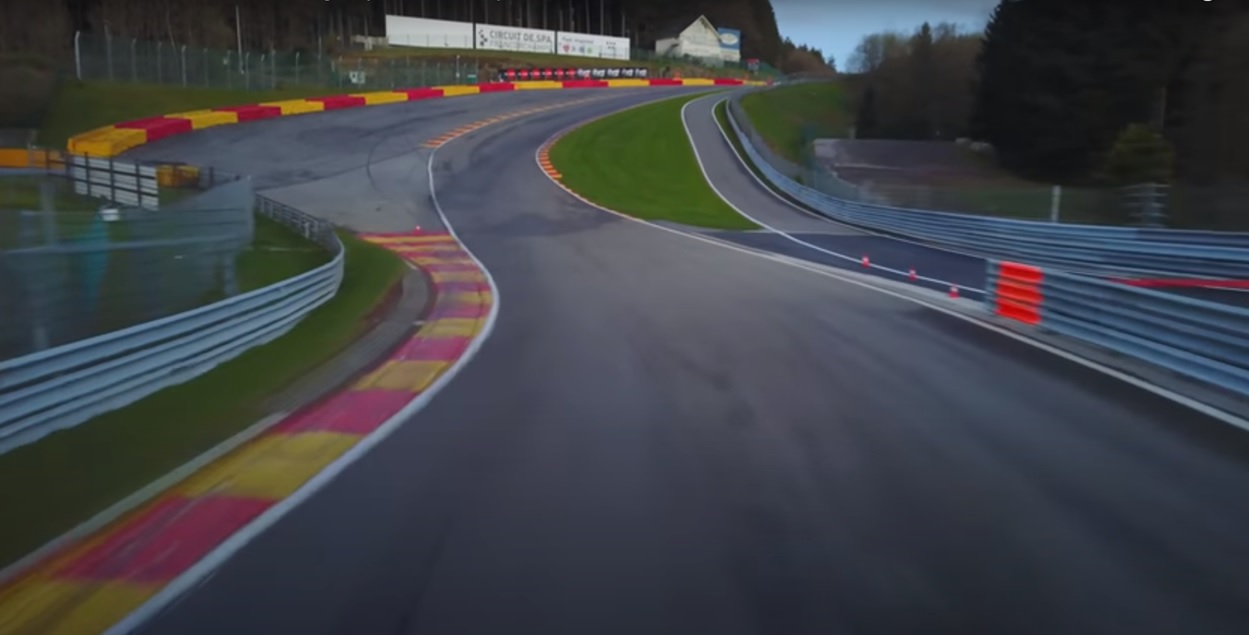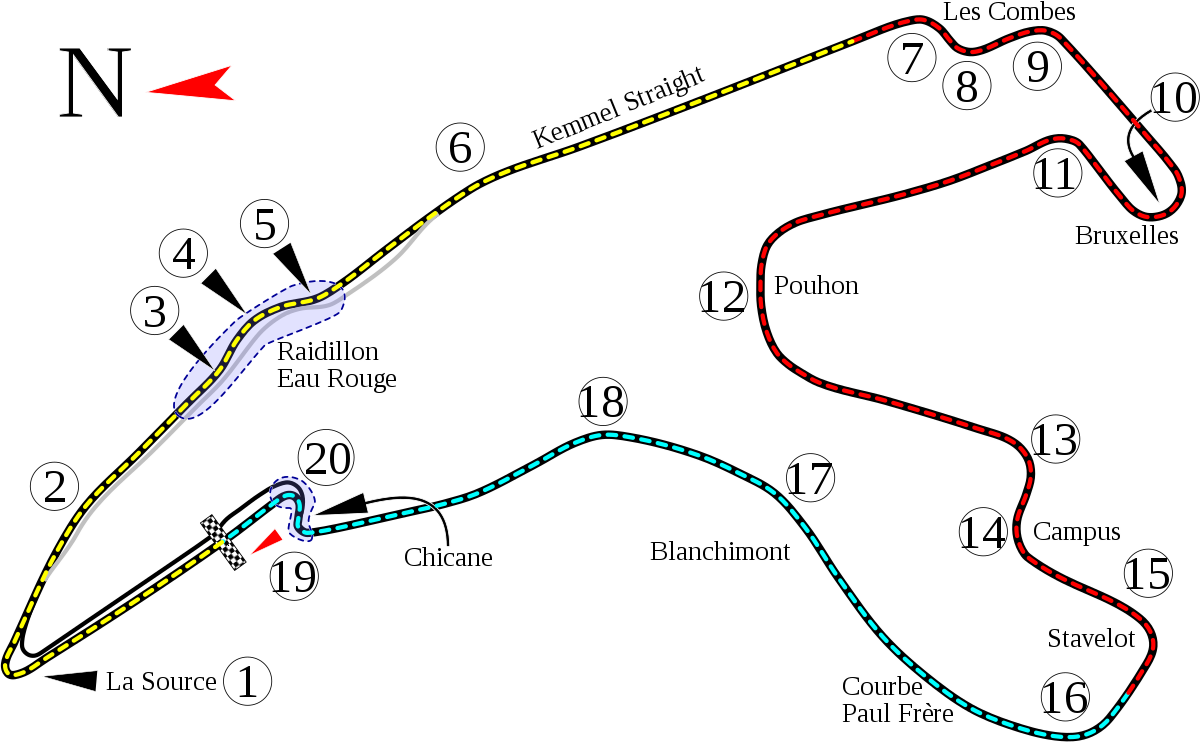
The most beautiful circuit in the world, Spa-Francorchamps, Belgium
What is the race fastest lap at Spa-Francorchamps ?: Valtteri Bottas currently holds the race lap record at Spa after he set a 1:46.286 on Lap 32 of the 2018 event while driving for Mercedes.
What is the fastest lap at Spa-Francorchamps ?: in qualifying laps 2020 Lewis Hamilton who took pole with a 1:41.252.
Regularly voted as tops by the drivers of the world, the Circuit of Spa-Francorchamps is part of the legendary motorsport tracks in the same way as Le Mans, Monza, or Indianapolis.
A regular theatre since 1985 of the F1 Grand Prix of Belgium, this legendary track, a little more than 7 km, the longest in the world championship, well deserves its official status of "the most beautiful circuit in the world".
This global label for the Spa loop is rarely disputed and must be due to its undulating profile, to its quick turns, with its famous and unique Raidillon, of course, but also to a natural and majestic setting, in the middle of forests of fir trees in which the noise of the engines resonate. A real jewel constantly adapted to the very latest in FIA safety standards with an infrastructure as well maintained as the legend.

Corner 1: La Source, also called the hairpin Source corner, is the first challenge to be taken on following the start. Designed in a U shape, it is the slowest corner on the circuit. It draws its name from the various water sources in the region and particularly in the Spa area.
Video https://share.vidyard.com/watch/MvnuP9oZDQ99BPj67dZBkp?
Corner 2-3-4-5 Le Raidillon de l’Eau Rouge is a stream which runs under the little bridge at the foot of the Raidillon. Anglophones allude to Eau Rouge and include the Raidillon without always naming it. The Eau Rouge is a tributary of the Amblève river which served as the border between the Roman and German empires and later between Belgium and Germany. Built in 1939, the Raidillon (literally the small steep road) has a drop of approximately 40 metres, from the start of the curve to the exit from the bend. The sequence of movement, considered by numerous drivers as the very best triple challenge in the world, requires great mastery, not just to stay on the road but also to approach the straight line leading to Combes at the highest possible speed. The Raidillon replaced the former tight bend of the old customs post with a shorter and faster design. It has been altered several times. The centrifugal force exerted by it requires great adroitness and superb knowledge of the area.
Video https://share.vidyard.com/watch/wPWS2rcgJRx63UfgZ95cGL?
Corner 6 Kemmel. The Kemmel ascent leads from the Raidillon to the Combes corner via a long ribbon of tarmac characterised by a slope and a curve which is taken on easily to the max. The highest instantaneous speed of the circuit is located at the end of the Kemmel climb.
Corner 7-8-9 Les Combes. The chicane of Combes (definition: small incised valley or gorge) is a very technical part of the circuit. A quick right-left punch opens up the bend to the right which determines the speed at the moment of approaching the descent toward Bruxelles
video https://share.vidyard.com/watch/iSQrS2FdLnuPfXb15CXdDn?
Corner 10 Bruxelles is a bend curving to the right which seems to be never ending. This turn has also been called Rivage, from the name of the hamlet nearby. Just after this challenge, a curve to the left, seemingly insignificant, has often taken drivers by surprise.
Video https://share.vidyard.com/watch/GqYBpgCkApVACDuPLpGaC9?
Corner 11 This little left is also called Speakers Corner because the only place this curve can be glimpsed is from the former speakers' booth.
Video https://share.vidyard.com/watch/VXSNdJuYkRYvWCfjJMbcFW?
Corner 12 The double left of Pouhon is a major challenge on the circuit. After a straight line of descent, the Pouhon is negotiated at dizzying speeds. On the etymological level, Pouhon is a ferruginous mineral spring which has given Spa its repute. The word means the place where the water springs from.
Video https://share.vidyard.com/watch/1a3wyEE8qzhUWoyHtTq6a8?
Corner 13-14 Fagnes. The double bend of Fagnes is approached at very high speeds as it follows a small right line after a very fast double left. The name used refers to the Fagnes (fens) region as the village of Francorchamps is located there.
Video: https://share.vidyard.com/watch/JJv2QYQr8vMuzfrFY7n7hj?
Corner 15 Campus. The Campus corner is a fast curve bending to the right and its name comes from Campus Automobile adjacent to the track. This is a centre of competence, specialising in technological training. This training is aimed mostly at engineers and technicians. The training centre is active in subjects such as automobile industry occupations, motorsports and in technological research.
Video:https://share.vidyard.com/watch/DZ2oPc3aJPk5rAt6jU8MXT?
Corner 16 Paul Frère. The Paul Frère corner is located at the junction between the 7004 metre track and the former portion of the circuit climbing from Stavelot towards Blanchimont. Paul Frère was the greatest racing driver and journalist of all time. Creator of numerous victories in Sport-Prototype, he finished 2nd in the Belgian Formula 1 Grand Prix in 1956. Invited by Enzo Ferrari, he took part in his 11th and last Grand Prix with an unprecedented performance.
Video: https://share.vidyard.com/watch/qHWvF1xMuGjuA2t3eDSN3m?
Corner 17-18 The double left of Blanchimont, which holds onto its eponymous village name, is a double bend that is particularly difficult to negotiate given the speeds attained. The tarmacing of all external clearances has made the passage considerably safer. Video: https://share.vidyard.com/watch/2811Sfwp1KAF8Qmpv497xC?
Corner 19-20 Chicane.The last challenge to approach is a slow corner in an S which bears the (un)original name of: Chicane. in the old days, it was alluded to as the "Bus Stop" as at that time when the track was open to traffic at certain times, there used to be a bus stop there. The right-left is particularly tight and negotiating it with good timing is essential, not only to end a fast lap in optimal conditions but also to start the next one well.After the chicane, the straight line leads the racing cars to la Source and we're off again!
Video: https://share.vidyard.com/watch/SWmYQDc9uH6ECe83HSdmCz?
Source: Wikipedia, Spa-Francorchamps circuit
Edited and videos 2021 by arrabbiata on Mx5 Nd, Nankang ar1, Tein suspension